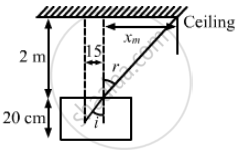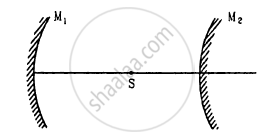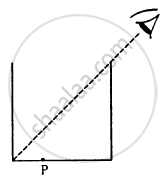Advertisements
Advertisements
प्रश्न
A container contains water up to a height of 20 cm and there is a point source at the centre of the bottom of the container. A rubber ring of radius r floats centrally on the water. The ceiling of the room is 2.0 m above the water surface. (a) Find the radius of the shadow of the ring formed on the ceiling if r = 15 cm. (b) Find the maximum value of r for which the shadow of the ring is formed on the ceiling. Refractive index of water = 4/3.
उत्तर
Given,
Height (h) of the water in the container = 20 cm
Ceiling of the room is 2.0 m above the water surface.
Radius of the rubber ring = r
Refractive index of water = 4/3
From the figure, we can infer:
\[\sin i = \frac{15}{25}\]
Using Snell's law, we get:
\[\frac{\sin i}{\sin r} = \frac{1}{\mu} = \frac{3}{4}\]
\[ \Rightarrow \sin i = \frac{4}{5}\]
From the figure, we have:
\[So, \]
\[\sin r = \frac{\tan r}{\sqrt{1 + \tan^2 r}}\]
\[ = \frac{\frac{x}{2}}{\sqrt{1 + \frac{x^2}{4}}}\]
\[ \Rightarrow \frac{x}{\sqrt{4 + x^2}} = \frac{4}{5}\]
\[\Rightarrow 25 x^2 = 16(4 + x^2 )\]
\[ \Rightarrow 9 x^2 = 64\]
\[ \Rightarrow x = \frac{8}{3} m\]
Total radius of the shadow = \[\frac{8}{3} + 0 . 15 = 2 . 81 m\]
(b)
Condition for the maximum value of r:
Angle of incidence should be equal to the critical angle, i.e., \[i = \theta_c\]
Let us take R as the maximum radius.
Now,
\[\sin \theta_c = \frac{\sin \theta_c}{\sin r}\]
\[ = \frac{R}{\sqrt{R^2 + 20}} = \frac{3}{4} (\sin r = 1)\]
\[ \Rightarrow 16 R^2 = 9 R^2 + 9 \times 400\]
\[ \Rightarrow 7 R^2 = 9 R^2 + 9 \times 400\]
\[ \Rightarrow R = 22 . 67 cm\]
APPEARS IN
संबंधित प्रश्न
Why can’t we see clearly through fog?
Name the phenomenon responsible for it.
What is linearly polarized light?
Describe briefly using a diagram how sunlight is polarised ?
A parallel beam of light is incident on a converging lens parallel to its principal axis. As one moves away from the lens on the other side on its principal axis, the intensity of light
A thin lens is made with a material having refractive index
\[\mu = 1 \cdot 5\]. Both the side are convex. It is dipped in water \[\mu = 1 \cdot 33\]. It will behave like
A 1 cm object is placed perpendicular to the principal axis of a convex mirror of focal length 7.5 cm. Find its distance from the mirror if the image formed is 0.6 cm in size.
A converging mirror M1, a point source S and a diverging mirror M2 are arranged as shown in figure. The source is placed at a distance of 30 cm from M1. The focal length of each of the mirrors is 20 cm. Consider only the images formed by a maximum of two reflections. It is found that one image is formed on the source itself. (a) Find the distance between the two mirrors. (b) Find the location of the image formed by the single reflection from M2.

A cylindrical vessel, whose diameter and height both are equal to 30 cm, is placed on a horizontal surface and a small particle P is placed in it at a distance of 5.0 cm from the centre. An eye is placed at a position such that the edge of the bottom is just visible (see figure). The particle P is in the plane of drawing. Up to what minimum height should water be poured in the vessel to make the particle P visible?

Light is incident from glass (μ = 1.50) to water (μ = 1.33). Find the range of the angle of deviation for which there are two angles of incidence.
Answer the following question in detail.
Is it possible to see primary and secondary rainbow simultaneously? Under what conditions?
Rainbow is the phenomenon due to ______.
Explain the formation of primary and secondary rainbow.
| Case study: Mirage in deserts |
 |
|
To a distant observer, the light appears to be coming from somewhere below the ground. The observer naturally assumes that light is being reflected from the ground, say, by a pool of water near the tall object. Such inverted images of distant tall objects cause an optical illusion to the observer. This phenomenon is called mirage. This type of mirage is especially common in hot deserts. Based on the above facts, answer the following question: |
A diamond is immersed in such a liquid which has its refractive index with respect to air as greater than the refractive index of water with respect to air. Then the critical angle of diamond-liquid interface as compared to critical angle of diamond-water interface will
| Case study: Mirage in deserts |
 |
|
To a distant observer, the light appears to be coming from somewhere below the ground. The observer naturally assumes that light is being reflected from the ground, say, by a pool of water near the tall object. Such inverted images of distant tall objects cause an optical illusion to the observer. This phenomenon is called mirage. This type of mirage is especially common in hot deserts. Based on the above facts, answer the following question: |
The following figure shows a cross-section of a ‘light pipe’ made of a glass fiber of refractive index 1.68. The outer covering of the pipe is made of a material of refractive index 1.44. What is the range of the angles of the incident rays with the axis of the pipe for the following phenomena to occur.

A short pulse of white light is incident from air to a glass slab at normal incidence. After travelling through the slab, the first colour to emerge is ______.
A passenger in an aeroplane shall ______.
